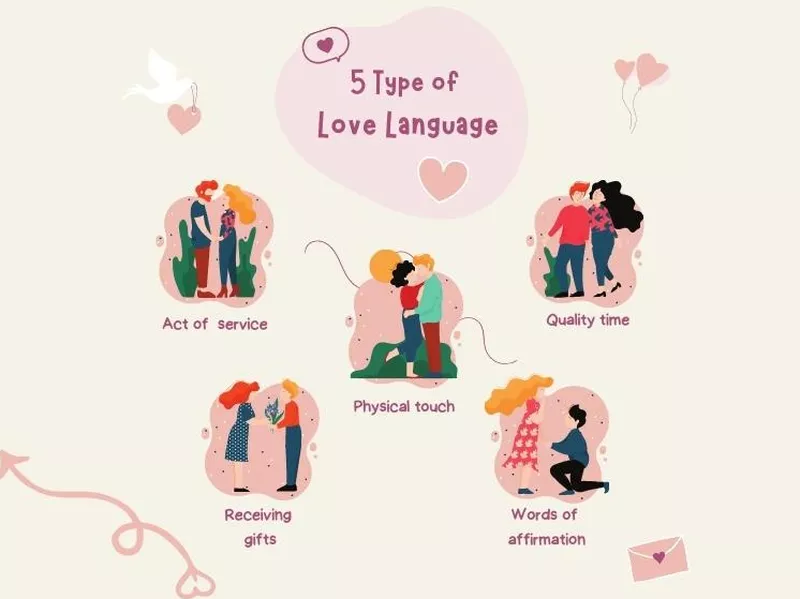For all our differences, there’s one thing every human being has in common: We all long for love. The desire to love and to be loved is the driving force for most of what we do. Since loving each other is an essential part of our existence, it’s only fitting that we’ve done our best to figure out the best way of doing so.
Experts were able to identify not one but five different love languages. This love language quiz will help you identify which love languages you speak, and it may give you a hint at how to better support your loved ones when they need it.
What’s a Love Language, Anyway?

Prostock-Studio / Getty Images
A love language is the way in which a person prefers to give or receive love and support. Some people prefer to give and receive love in the same way, while others like to receive it in one way and give it in another.
There’s no right or wrong way to show love, of course. It’s all a matter of preference. The concept was invented by Gary Chapman in the 1990s. While he isn’t a psychologist, his book became a bestseller, and hundreds of thousands of readers are adamant that love languages are real, relatable and incredibly helpful to understand.
Knowing Your Love Language Helps in So Many Ways

kupicoo / Getty Images
Have you ever had a relationship in which you and your partner keep trying to do nice things for each other, but every attempt seems to be a swing and a miss? That may be because you’re showing love in a way that doesn’t resonate with their natural love language.
Understanding your own love language and that of those you care about the most can help you to understand each other better and offer support in ways that actually hit home.
There Are Five Love Languages. Which One Do You Speak?

Canva
Giving someone flowers won’t cheer them up much if what they’re really craving is a pep talk or a hug. There are five different love languages, including the following:
- Words of affirmation
- Acts of service
- Gifts
- Quality time
- Physical touch
Since it’s possible to prefer to give and receive love in different ways, we’ll go over what each love language looks like from both sides.
Words of Affirmation

Mirel Kipioro / Getty Images
The words of affirmation love language is all about verbal communication. Think pet names, compliments and saying “I love you” out loud whenever you have the chance.
People with this love language are also the ones who find insults or arguments the most hurtful.
Signs Words of Affirmation Is Your Giving Love Language

shapecharge / Getty Images
If your natural inclination is to shower your loved ones with friendly compliments, and you’re always ready and willing to sit down for a long heart-to-heart, words of affirmation is your given love language.
Signs Words of Affirmation Is Your Receiving Love Language

kokoroyuki / Getty Images
If nothing makes you feel more appreciated than receiving an unsolicited good morning text or hearing, “Great job on that presentation!” from your boss, words of affirmation is your receiving love language.
Other great ways to offer words of affirmation include:
- Sending encouraging text messages
- Letting someone know you’re proud of them and explaining why
- Making compliments intentional and specific
- Keeping your words genuine and meaningful
Acts of Service

Rawpixel / Getty Images
People who value action over words call their love language “acts of service.” The acts of service love language is all about showing each other that you care by doing them favors and helping them out in concrete ways.
That means supporting your loved one by making their life easier rather than by affirming them verbally.
Signs Acts of Service Is Your Giving Love Language

PeopleImages / Getty Images
If you’re the first one to volunteer to help a friend move, deliver meals to your cousin who just had a baby or bake cookies for your kiddo after a hard week at school, acts of service is your giving love language.
You like to show your love by making yourself useful and doing helpful things for people.
Signs Acts of Service Is Your Receiving Love Language

AntonioGuillem / Getty Images
If acts of service is your receiving love language, you feel the most cared for when your partner says something like, “Let me do that for you.”
Small things like someone taking care of a chore you’ve been putting off or picking up new batteries for the smoke alarm go a long way. People with this love language don’t take kindly to broken commitments and flakiness. Follow-through is a big deal!
Other ways to show this love language include:
- Holding the door open for someone
- Helping a child with homework or a fun project they’re working on
- Cooking for someone
- Fixing things around the house without being asked
Gifts

LuckyBusiness / Getty Images
The gift-giving love language gets a bad rap. Some people assume that wanting to receive gifts means an individual is materialistic or shallow, but that’s far from the truth.
For those who appreciate gift-giving the most, it’s more about thoughtfulness than an item’s dollar value.
Signs Gifts Are Your Giving Love Language

PeopleImages / Getty Images
If you go all out for every single holiday, showering your favorite people with surprises for Valentine’s Day, Easter, Halloween and everything in between, gift-giving is your love language.
Gift-givers get excited to watch loved ones open presents because each one they give is thoughtfully planned out.
Signs Gifts Are Your Receiving Love Language

FG Trade / Getty Images
For those who light up when their partner buys them that necklace they were eyeing or who eagerly anticipates Christmas morning even though they’re too old for Santa, gift-giving is the way to go. Gift-giving doesn’t have to be a costly endeavor. Showing love via gift-giving is mostly about consideration and care. These ideas can get you started:
- Picking a flower in your partner’s favorite color while you’re walking the dog
- Noticing their likes and dislikes and giving them small gifts to match — like a latte just the way they like it from their favorite coffee shop
- Remembering important holidays and milestones
- Saving mementos from shared experiences, like a trinket from a trip you took together
Quality Time

FG Trade / Getty Images
Quality time is all about providing loved ones with attention. It doesn’t mean the recipient is an attention hog. It just means they feel the most loved when someone is willing to give them their full attention, even if it’s only for a short amount of time.
People with this language tend to feel neglected or hurt if someone’s multitasking during movie night or responding to work messages at dinner.
Signs Quality Time Is Your Giving Love Language

AleksandarNakic / Getty Images
If you love to plan special date nights, excursions and vacations with your friends and family, quality time is your giving love language.
You’re probably the member of the friend group who suggests hosting a game night or museum meetup. You probably also prefer dates in laidback settings that cater to conversations and deeper connection.
Signs Quality Time Is Your Receiving Love Language

Hiraman / Getty Images
If quality time is your receiving love language, you feel the most loved and secure when someone makes time for you. This one’s pretty easy to execute, but some examples are:
- Making phones off-limits at the dinner table
- Planning regular date nights
- Asking your partner questions and making time to hear their answer
- Taking a class or joining a club together
Physical Touch

JLco – Julia Amaral / Getty Images
Physical touch doesn’t have to be sexual in nature. It can be completely innocent; even children can find comfort in physical affection.
Physical affection is the love language of anyone who needs hugs and a hand to hold when they’re feeling down.
Signs Physical Touch Is Your Giving Love Language

triloks / Getty Images
If your friend is upset and your first reaction is to give them a bear hug or a reassuring pat on the back, physical touch is your giving love language.
You’re a touchy-feely type who is very comfortable showing affection with loved ones through snuggles and hugs.
Signs Physical Touch Is Your Receiving Love Language

g-stockstudio / Getty Images
If you feel disconnected with your partner when they sit on the other side of the couch instead of curling up right beside you, physical touch is likely your receiving love language. Other ways to offer affection through physical touch include:
- Offering a back rub after a long day
- Stroking the forehead of a child who isn’t feeling well
- Holding hands
- Braiding or playing with hair
- Kissing someone goodbye
Love Languages: The Bottom Line
Love languages aren’t just a romantic thing. Understanding the love languages of your parents, your kids and your friends can help you connect with them on a deeper level and make them feel seen.
Share this post with your favorite people and learn about your love languages together. It’s also possible to have a secondary love language, so don’t feel limited to picking just one!